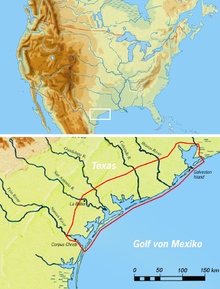
Back شعب كارانكاوا ARZ Каранкауа Bulgarian Karankawes Catalan Karankawa German Karankavoj Esperanto Karankawa Spanish Karankawat Finnish Karankawas French Karankawa Croatian Karankawa Italian
 Karankawa territory | |
| Total population | |
|---|---|
| extinct as a tribe since the 19th century[1] | |
| Regions with significant populations | |
| United States (Texas) | |
| Languages | |
| Karankawa language, English, Spanish | |
| Religion | |
| Indigenous religion |
The Karankawa /kəˈræŋkəwə/[2] were an Indigenous people concentrated in southern Texas along the coast of the Gulf of Mexico, largely in the lower Colorado River and Brazos River valleys.[3] They consisted of several independent, seasonal nomadic groups who shared a language and some culture.
From the onset of European colonization, the Karankawa had violent encounters with the Spanish. After one attack by the Spanish, who ambushed the Karankawa after the establishment of Presidio La Bahía in 1722, the Karankawa allegedly felt "deeply betrayed [and] viewed Spanish colonial settlement with hostility."[4]
In the 1820s, European-American colonists arrived in their land under the leadership of Stephen Austin. He commissioned a captain to expel the Karankawa from the Austin land grant,[5][6] leading to multiple attacks by whites, including the Skull Creek massacre of 19 Karankawa.[7] By the 1840s, the Karankawa, now exiled, split into two groups, one of which settled on Padre Island while the other fled into the Mexican state of Tamaulipas. During 1858, Mexican rancher Juan Nepomuceno Cortina led a group of Mexicans and Texan colonists against what was believed to be the Karankawa's last known refuge, killing many.[6] By 1891, the Karankawa ceased to exist as a functioning tribe.
Historical research of the Karankawa is hindered because the documents concerning them were overwhelmingly written by enemies of the tribe.[5][6][8] The Karankawa had been described for centuries as "cannibals," now believed by many to be a falsehood initially spread by the Spanish after failing to convert them to Catholicism at missionary settlements in La Bahía and Refugio. Years later, Texan colonist John H. Moore attempted to justify his role in the massacre of Karankawa because "their cannibalism... [was] beyond question," despite the absence of evidence.[7][9]
- ^ Cite error: The named reference
coastwas invoked but never defined (see the help page). - ^ "Karankawa". Oxford English Dictionary (Online ed.). Oxford University Press. (Subscription or participating institution membership required.)
- ^ "Karankawa." In Cassell's Peoples, Nations and Cultures, edited by John Mackenzie. Cassell, 2005.
- ^ Ricklis, Robert A. (2010). The Karankawa Indians of Texas: An Ecological Study of Cultural Tradition and Change. University of Texas Press. p. 2. ISBN 9780292770775.
- ^ a b Gatschet, Hammond & Williams Oliver 1891
- ^ a b c Wolff, Thomas (1969). "The Karankawa Indians: Their Conflict with the White Man in Texas". Ethnohistory. 16 (1): 1–32. doi:10.2307/480941. JSTOR 480941.
- ^ a b Anderson, Gary Clayton (2005). The Conquest of Texas: Ethnic Cleansing in the Promised Land, 1820-1875. University of Oklahoma Press. pp. 53–54. ISBN 9780806136981.
- ^ Geneser, Vivien L. (2011). "Native transgressions: a look at the portrayal of Karankawa natives in Texas history textbooks and trade books". American Educational History Journal. 38 (1–2): 219+. Retrieved February 25, 2018 – via Academic OneFile.
- ^ La Vere, David (2004). The Texas Indians. Texas A&M University Press. p. 62. ISBN 9781585443017.